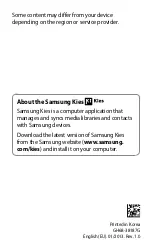
Health and Safety Information
164
•
International Commission on Non-Ionizing Radiation Protection:
http://www.icnirp.de
•
National Radiation Protection Board (UK):
http://www.nrpb.org.uk
•
Updated 4/3/2002: US food and Drug Administration
http://www.fda.gov/cellphones
Road Safety
Your wireless phone gives you the powerful ability to
communicate by voice, almost anywhere, anytime. But an
important responsibility accompanies the benefits of wireless
phones, one that every user must uphold.
When driving a car, driving is your first responsibility. When
using your wireless phone behind the wheel of a car, practice
good common sense and remember the following tips:
1. Get to know your wireless phone and its features, such as
speed dial and redial. If available, these features help you to
place your call without taking your attention off the road.
2. When available, use a hands-free device. If possible, add an
additional layer of convenience and safety to your wireless
phone with one of the many hands free accessories available
today.
3. Position your wireless phone within easy reach. Be able to
access your wireless phone without removing your eyes from
the road. If you get an incoming call at an inconvenient time, let
your voice mail answer it for you.
4. Let the person you are speaking with know you are driving; if
necessary, suspend the call in heavy traffic or hazardous
weather conditions. Rain, sleet, snow, ice and even heavy
traffic can be hazardous.
Summary of Contents for SGH-X426
Page 4: ...iv ...
Page 32: ...Call Functions 28 ...
Page 46: ...Phonebook 42 ...
Page 54: ...Entering Text 50 ...
Page 62: ...Options During a Call 58 ...
Page 72: ...Recent Calls 68 ...
Page 102: ...Network Services 98 ...
Page 106: ...Games 102 ...
Page 108: ...Download 104 ...
Page 114: ...Sound Settings 110 ...
Page 138: ...My Browser 134 ...
Page 148: ...Phone Settings 144 ...
Page 152: ...Solving Problems 148 ...
Page 156: ...Access Codes 152 ...
















































